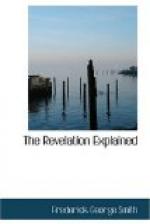13. And in the midst
of the seven candlesticks one like unto the
Son of man, clothed with a
garment down to the foot, and girt
about the paps with a golden
girdle.
14. His head and his
hairs were white like wool, as white as
snow; and his eyes were as
a flame of fire;
15. And his feet like
unto fine brass, as if they burned in a
furnace; and his voice as
the sound of many waters.
16. And he had in his
right hand seven stars: and out of his
mouth went a sharp two-edged
sword: and his countenance was as
the sun shineth in his strength.
17. And when I saw him,
I fell at his feet as dead. And he laid
his right hand upon me, saying
unto me, Fear not; I am the first
and the last:
18. I am he that liveth,
and was dead; and, behold, I am alive
for evermore, Amen; and have
the keys of hell and of death.
The hieroglyphic, or symbolic, characters now begin. Turning in the direction from which the voice came, John saw seven beautiful candle-sticks and standing in their midst, a personage whose appearance was inexpressibly glorious. John had recognized the voice of Christ announcing “I am the first and the last,” but he was not prepared for the sight that met his gaze when he turned and found himself in the immediate presence of his August Majesty, the Son of God. A human form was there, but clothed in such vestments as proclaimed God; and no wonder mortality was overwhelmed when ushered into the presence of the uncreated Deity—he whose feet glowed as brass in a furnace, whose eyes were as a flame of fire, and whose voice was as the sound of many waters. Any man would have fallen as dead before such a personage as is here described. Men may talk atheism, but it is the atheism of the lips and of a coward heart, an atheism that would flee appalled before the burning footsteps of the Deity, and the irresistible conclusion would be, “It is God himself.”
John was not left in doubt regarding the identity of this personage; for, laying his hand upon the prostrate form of the apostle, he said, “Fear not; I am the first and the last: I am he that liveth, and was dead; and, behold, I am alive forevermore, Amen; and have the keys of hell and of death.” The ever-living One entered death’s domains and permitted himself to be bound with chains; but at his pleasure he broke them asunder, conquered death, and rose triumphant, carrying with him the keys of hell and of death; and he has ascended on high, alive forevermore; and at his voice all the dead will arise at his appearing, for the grave can no longer hold its victims.
This vision settles an important fact—that when Christ appears upon the panoramic scene, he comes in his own person, and not in the character of a created substitute. There may be symbols connected with his person—the sword of his mouth may signify vengeance upon his enemies; his eyes as a flame of fire, superior intelligence and penetrating vision, etc.—but he distinctly announces himself to be the Christ of God. There is no creature in the universe that could personate “him that liveth, and was dead, but is alive forevermore.”




